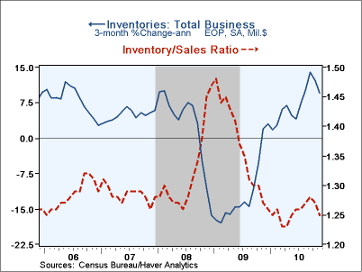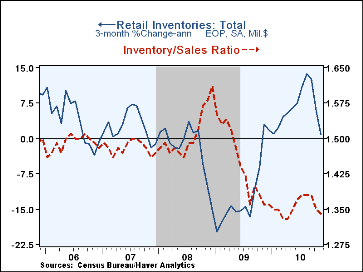 Global| Jan 17 2011
Global| Jan 17 2011U.S. Business Inventory Accumulation Slows
by:Tom Moeller
|in:Economy in Brief
Summary
After several months of strong gain, the rate of business inventory accumulation slowed to 0.2% in November after a 0.8% October increase, initially reported at 0.7%. During the last three months inventories rose at a 9.5% annual rate [...]
 After several months of strong gain, the rate of business inventory
accumulation slowed to 0.2% in November after a 0.8% October increase, initially
reported at 0.7%. During the last three months inventories rose at a 9.5% annual
rate versus the recent peak of 14.0%. Recent inventory accumulation certainly
was voluntary since it accompanied a 1.2% increase (8.5% y/y) in business sales.
However, the sales gain also has slowed recently. Despite all the inventory
accumulation, the inventory-to-sales ratio at 1.25 was just slightly below where
it was before the recession began. That represents a significant correction
after the unwanted surge during the economic downturn.
After several months of strong gain, the rate of business inventory
accumulation slowed to 0.2% in November after a 0.8% October increase, initially
reported at 0.7%. During the last three months inventories rose at a 9.5% annual
rate versus the recent peak of 14.0%. Recent inventory accumulation certainly
was voluntary since it accompanied a 1.2% increase (8.5% y/y) in business sales.
However, the sales gain also has slowed recently. Despite all the inventory
accumulation, the inventory-to-sales ratio at 1.25 was just slightly below where
it was before the recession began. That represents a significant correction
after the unwanted surge during the economic downturn.
The picture of quicker inventory accumulation is hardly broad-based. Retail inventories in fact fell slightly in November led by a 0.8% drop (+13.7% y/y) in motor vehicles. Less autos, inventories increased 0.2% and during the last three months rose at a 1.7% rate versus the May peak of 7.5%. Strict management of inventories dropped the retail nonauto I/S ratio to an all-time low. During November, a 1.2% jump (4.5% y/y) in furniture was accompanied by a 0.1% increase in general merchandise (4.0% y/y). Apparel inventories slipped 0.3% (+0.8% y/y).
In the wholesale sector, inventories fell 0.2% despite a 0.2% increase in petroleum (18.4% y/y) with higher prices. Less petroleum, wholesale inventories slipped 0.2% during November but rose 7.9% y/y. In the factory sector, inventories jumped another 0.8% (6.6% y/y) following the 8.8% decumulation during 2009.
The business sales and inventory data are available in Haver's USECON database. Note that in a value-added feature, the database includes series calculated by Haver database managers showing sales, inventories and I/S ratios for total business less motor vehicle dealers and related wholesale operations.
Monetary Policy and the Role of Dissent is from the Federal Reserve Bank of Kansas City and it can be found here.
| Business Inventories (%) | Nov | Oct | Sept | Year Ago | 2009 | 2008 | 2007 |
|---|---|---|---|---|---|---|---|
| Total | 0.2 | 0.8 | 1.3 | 6.8 | -9.8 | 0.8 | 4.0 |
| Retail | -0.0 | -0.6 | 0.8 | 5.7 | -10.4 | -3.3 | 2.5 |
| Retail ex Motor Vehicles | 0.2 | -0.2 | 0.4 | 2.9 | -4.9 | -1.9 | 2.7 |
| Wholesale | -0.2 | 1.7 | 2.1 | 8.4 | -10.5 | 3.7 | 6.4 |
| Manufacturing | 0.8 | 1.1 | 1.1 | 6.6 | -8.8 | -0.8 | 7.6 |
Tom Moeller
AuthorMore in Author Profile »Prior to joining Haver Analytics in 2000, Mr. Moeller worked as the Economist at Chancellor Capital Management from 1985 to 1999. There, he developed comprehensive economic forecasts and interpreted economic data for equity and fixed income portfolio managers. Also at Chancellor, Mr. Moeller worked as an equity analyst and was responsible for researching and rating companies in the economically sensitive automobile and housing industries for investment in Chancellor’s equity portfolio. Prior to joining Chancellor, Mr. Moeller was an Economist at Citibank from 1979 to 1984. He also analyzed pricing behavior in the metals industry for the Council on Wage and Price Stability in Washington, D.C. In 1999, Mr. Moeller received the award for most accurate forecast from the Forecasters' Club of New York. From 1990 to 1992 he was President of the New York Association for Business Economists. Mr. Moeller earned an M.B.A. in Finance from Fordham University, where he graduated in 1987. He holds a Bachelor of Arts in Economics from George Washington University.








